The Secret Ingredient, Paynes Grey
By Iffy
Every miniature figures painter has their own special technique or tool. Mine is Liquitex Paynes Grey. I use it as an almost universal shading wash. Using a combination of Paynes Grey and drybrushing, you can go from basecoat to tabletop in a matter of minutes.
What is Paynes Grey?
Wikipedia gives this definition of Paynes Grey: Payne's grey is a very dark blue-grey used in painting. It can be used as a mixer in place of black. Being less intense than black, it is easier to get the right shade when using it as a mixer. Payne's grey is a mixture of ultramarine and black or of Ultramarine and Sienna. The colour is named after William Payne, who painted watercolours in the late 18th century.
Where do I find it?
Most art stores sell acrylic Paynes Grey from a number of manufacturers. Personally, I use the Liquitex, Paynes Grey, Soft Body Artist Colors brand and have been for years. It comes in a 2 oz squeeze jar and can be found at most art supply stores.

So What?
Because it's actually a deep blue-grey, it can deepen and shade a number of colors without making them look dirty, as a true black would do. I use Paynes Grey to shade reds, browns, greys, blues, greens, and even light colors. Not only does this make Paynes Grey very utilitarian, you can use larger brushes to apply it and that translates into painting speed. As a side note, for lighter tans, browns, and brass colors, I use another Liquitex paint, Burnt Umber for those washes.
Liquetex Paynes Grey is also an absolute bargain compared to the other products currently available. A 12 ml pot of Citadel Badab Black will run you $3.00, or $0.25 per ml. A 2 oz (59 ml) bottle of Liquitex Paynes Grey costs around $4.00 or $0.068 per ml, probably half of that when you consider that you have to dilute the Liquitex product. This means that Liquitex is somewhere in the range of 8+ times more cost effective than buying the comparable Citadel product. I recently washed an Ork Trukk, and had I used the Badab Black, I probably would have gone through a whole pot of Citadel wash.
How do I use it?
The Liquetex Soft Body Artist Colors aren't really useable right from the bottle. They're very thick, and as such, need to be diluted first so that it can work as a wash. I typically squeeze mine into a ceramic plate. This allows me to mix in water and glaze medium without loosing any of my wash. There is really no precise formula to the mix because I can't really convert a squirt of Liquitex into a drop equivalent. Suffice to say that I squeeze a little bit of Liquitex onto the plate, add 5-7 drops of Vallejo Glaze Medium to improve flow, and then use a straw to add a couple of drops of water. I mix it with a brush until it "looks" right. Generally, I want it diluted enough so that the wash actually looks blue-grey and not black and is around the consistancy of milk. I also paint a couple of test strips over some base color I've laid down on some newspaper so I get an idea of how the wash will cover the basecoat. I do this, adjust the amount of water, and test again until I'm happy.
What does the Paynes Grey wash do?
I will be easier if I illustrate the effect of the wash by comparing and contrasting the results I get with my typical Paynes Grey wash vs. a typical basecoat. I prepped a number of Brettonian archers using a wide range of colors. Here are the colors I used to basecoat the figures. The colors were chosen to showcase a range of colors, not necessarily because I thought this is what I wanted my archers to look like.
- Helmet - VMC Gunmetal
- Tunic - Citadel Blood Red
- Tunic - Citadel Ultramarine Blue
- Flesh - Citadel Bronzed Flesh
- Arrows and Bow - Citadel Beastial Brown
- Leggings and hood - P3 Iosan Green
- Shoes and pouch - Citadel Beastial Brown
Here are the results, showing the front and back of the figures. On the left (#1) is the basecoated figure. On the right (#2) is the equivalent figure completely washed with a mix of Liquitex Paynes Grey, Liquitex Glaze Medium, and some water. The mix was applied with a #5 brush.
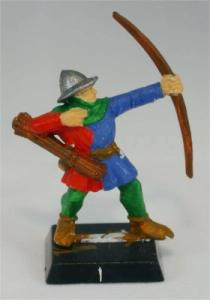
Plain basecoat, front
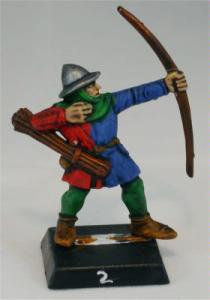
Single wash of Paynes Grey, front
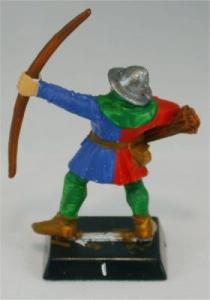
Plain basecoat, back
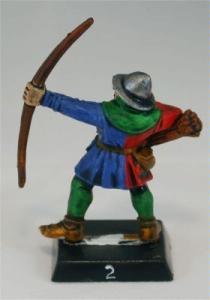
Single wash of Paynes Grey, back
As you can see, the single wash of Paynes Grey has deepened and shaded all of the colors, except maybe the flesh, without making everything look dirty. At this point, this archer would be tabletop acceptable with a quick basing job. Drybrushing or highlighting with the original basecoat colors will brighten the figure a bit and sharpen the textures.
So, how does the Paynes Grey wash compare to the Citadel Washes? Here is another comparison, showing the same Paynes Grey-washed figure against an archer that has been washed using the Citadel products. I used the following washes over the basecoats listed above:
- Helmet - Badab Black
- Tunic - Baal Red
- Tunic - Asurmen Blue
- Flesh - Ogryn Flesh
- Arrows and Bow - Devlan Mud
- Leggings and hood - Thrakka Green
- Shoes and pouch - Gryphonne Sepia
The figure on the left (#2) is the product of a single wash of Paynes Grey. The figure on the right (#3) had each color washed with the appropriate Citadel wash. Honestly, I think the Paynes Grey did a nicer job of shading the recesses and it only took a single wash.

Single wash of Paynes Grey, front
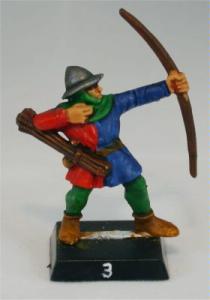
Washed with Citadel washes, front

Single wash of Paynes Grey, back
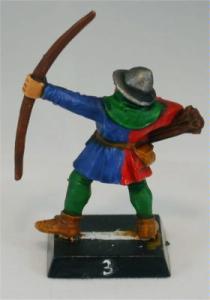
Washed with Citadel washes, back
Last thoughts. As you wash, just make sure that you wick up any large pools of wash to make sure they don't dry as big black spots.
The original article can be found here http://www.kan.org/michael/mkp/paynes_grey.php